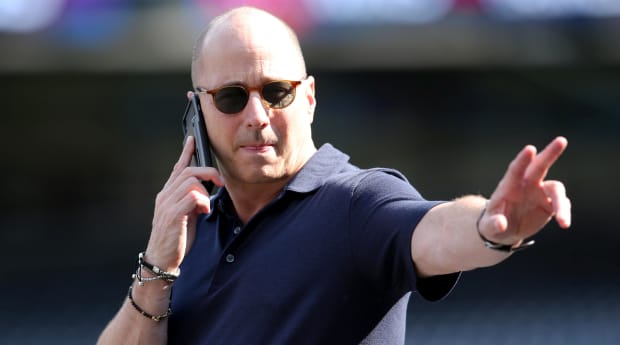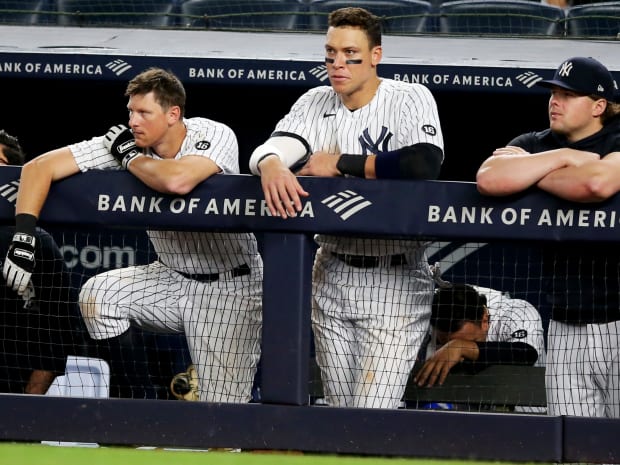New York appears to be competing for the second wild card. Is there a deal Brian Cashman can make to improve this team?
Welcome to The Opener, where every weekday morning you’ll get a fresh, topical column to start your day from one of SI.com’s MLB writers.
To borrow a decade-old coinage from Brian Cashman, the time has arrived for the Yankees and their general manager to “smoke the objective pipe.” Are the Yankees good enough to be a postseason team? Their next three games—against the Rays—and the trade deadline Friday demand honesty. Their season and direction come down to four days.
Cashman’s Yankees are not the only should-be playoff contender that has reached decision time. For various reasons, the Braves, Nationals, Cardinals, Cubs and Cleveland are worse than their roster resources suggest. None look like a playoff team right now. The challenge for front offices this time of year for such disappointing teams is how to weigh hope against the hard truths four months of baseball have revealed.

The Yankees are 51-47 after 98 games with a run differential that suggests worse (+5). Cashman found himself in nearly an identical spot in 2016. After game number 98 then, Cashman’s puff on the objective pipe convinced him to trade his best relief pitcher, Aroldis Chapman—six days before the trade deadline. He then also traded Andrew Miller. The differences are only slight between when he traded Chapman and where his team stands now:
Yankees After 98 Games
This year Cashman does not have a great trade chip in his walk year, as were Chapman and Miller in 2016. His choice now is whether to try to fix this team with a trade that depletes a thin farm system and nudges the team over the Competitive Balance Tax threshold. Is Starling Marte really going to make a difference? Joey Gallo? Joc Pederson? Joe Ross? Tyler Anderson? Robbie Grossman?
The weekend in Boston pushed the Yankees further from the realm of genuine pennant contender. They held a lead in all four games at Fenway Park and lost three of them, blowing leads in the fifth, eighth and ninth innings.
With such high-visibility collapses—layered atop several other “gut punch” losses, as manager Aaron Boone calls them, to the Twins, Angels, Astros and Mets in recent weeks—it is easy to heap blame on the bullpen. But the larger, more systemic problem is the New York offense. In the four games at Fenway, the Yankees hit .225 with one home run and scored 3.5 runs per game.
“They’re just not that good of an offensive team,” said one rival talent evaluator. “They haven’t hit much all year, and some of their problems go back to last year.”

These are the trendlines Cashman must consider when he is honest about his team:
• The Yankees have 51 or fewer wins in their first 98 games for the 35th time in franchise history. Only one of those previous 34 Yankees teams made the postseason: the 1995 wild-card winners. Only one of those 34 teams won 90 games (1970). These Yankees will have to play .609 (39-25) baseball just to get to 90 wins.
• The Yankees’ 3-through-6 hitters have the franchise’s fifth-worst OPS since in the Live Ball Era began in 1920.
• Yankees’ first basemen have the second-worst OPS in franchise history. Only in 1982 was their production at first base worse.
• After four seasons in which they were first or second in the AL in runs per game, the Yankees are tied for 12th. Only the Mariners and Rangers have more trouble scoring runs.
• The Yankees are 8–17 against Boston and Tampa Bay while hitting .206.
• Giancarlo Stanton essentially has become a DH-only, which limits lineup flexibility. In his four seasons with New York, Stanton’s sprint speed has declined every year, from 27.8 to 27.1 to 25.7 to 24.6.
• The Yankees built their offense on home runs, which was a great idea in 2019 with the rabbit ball, but troublesome in 2021 with the ball that has more drag. Compared to 2019, the MLB rate of flyballs that are home runs is down 16.6% this year. The Yankees’ decline is almost double the average rate. Their flyballs are carrying for home runs 31.8% less often than in 2019—with the same average exit velocity.
Yankees Fly Balls
The AL East is almost out of reach for New York with 64 games to play, especially if it does not win the series at Tampa Bay. The Yankees appear to be competing with Oakland and Toronto for the second wild card—a one-game playoff on the road. Their odds of reaching the postseason, depending on your favorite algorithm, range from 11% to 37%. It is a steep hill to climb.
Likewise, the Braves never have been better than .500 this year and lost their best player, Ronald Acuña Jr., for the year. The Nationals are so far out (8 games) with no sign of Stephen Strasburg returning that they should consider moving Max Scherzer as this year’s version of the 2016 Chapman. Cleveland, outscored by 31 runs, have no player off the table, including José Ramírez. The Cubs are clear sellers and the Cardinals, who have been just as mediocre, also should be.
If the Yankees do make a move, it should be with an eye toward fixing the offense for next season, not just a rental for the next two months. With outfielders Brett Gardner and Clint Frazier combining to hit .192 over 486 plate appearances, the best fit would be a versatile hitter such as Bryan Reynolds from Pittsburgh.
The more likely course is the Yankees keep relying on the offense “coming around,” especially with 22 of their final 61 games against five of the seven worst teams in baseball (Marlins, Orioles, Royals, Twins and Rangers). Decision time is here.
More MLB Coverage:
• Inside Alex Cora’s Second Chance After Scandal
• Rays Find New Sense of Urgency to Heat Up AL East Race
• How Vlad Guerrero Jr. Can Still Win AL MVP in the Year of Ohtani
• Trade Deadline Roundtable: Let's Make a Deal
No comments:
Post a Comment